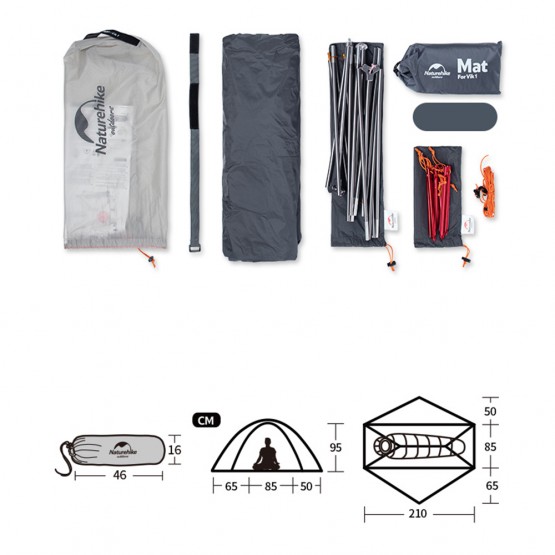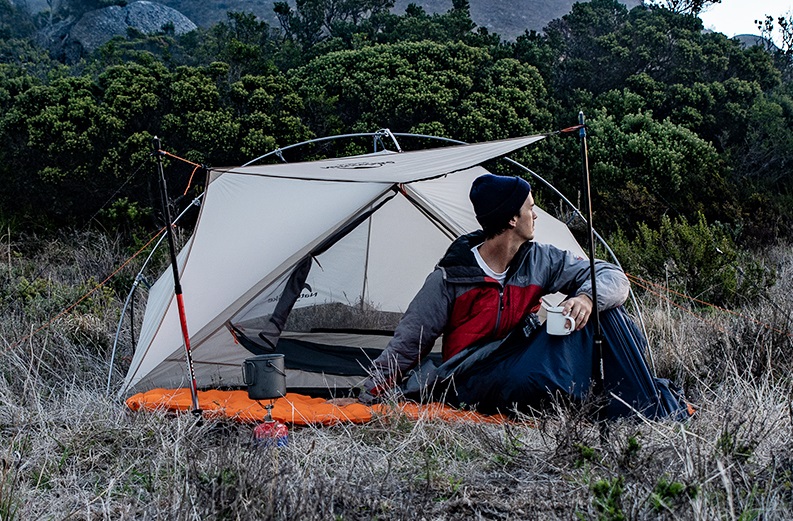Hi folks. This week on the blog we’re taking a look at the Naturehike VIK Tent – a new single skin shelter that’s offers something very different! We’ve been blown away by the quality of other Naturehike tents such as the Cloud Up, and the VIK is another step up in both weight and comfort. It’s also got lots of cool and innovative features that we’ll look at in a moment. But first, let’s dive in and take a look at the specs for the VIK.
Design
The Naturehike VIK comes in two basic configurations: with or without an attached ‘snow skirt’. The design involves a forked, single pole running from the back of the tent to the front. A short cross-pole at the top of the tent ensures tension at the sides. The VIK is free-standing, with a single entrance and vestibule on the side.
One design feature that I love about this tent is that you can create a canopy by propping up the door with trekking poles and guy ropes. It’s a simple thing, but it will make a huge difference to the sense of space that you get with this shelter. If the weather turns against you then this makeshift canopy would be useful for cooking under too.
Another innovative feature of the Naturehike VIK is the way the air vent opens. A lot of shelters have vents that prop open from the outside, meaning you always have to get out of the tent first. Who the hell wants to do that in the middle of the night!? With the VIK, you can actually open the vent from the inside. You simply detach a small pole from its velcro housing, push it up through a hole inside the tent, and boom – instant airflow. I’ve lost count of the number of times I’ve wanted to aerate my tent from the inside, so this is a major plus.
Materials
The VIK is rated as a 4-season shelter, but it’s only single-skinned. Although single-skin tents do have an image problem when it comes to condensation, I’ve never found this to be an issue on more modern designs. As always, airflow is key, and having such an open design, with a vent that opens from inside, will help a lot with this.
The fly is made from 15D Silicon-coated Nylon, with Aluminium poles. The material used for the stakes isn’t listed, but we suspect these would probably be Aluminium as well. The skirts on the tent door clip closed with magnets, which is a neat touch. Man, I love magnets.

Size & Weight
The total packed weight for the VIK is 1060 grams – that’s if you’re buying the version without the snow skirt. If you want the snow skirt too, that pushes the weight to 1100 grams. The trail weight for the VIK is 970 grams or 930 grams (with and without snow skirts respectively).
In my experience, ‘trail weight’ is often optimistic, and packed weight is sometimes excessive. So it’s best to assume that the actual weight for this tent is going to fall somewhere between 930 and 1100 grams when you’re taking it out on the trail. The pack size is a neat and tidy 46 x 16 cm. In terms of interior space, there’s a fairly roomy – for one person at least – 85 x 210 cm.

Naturehike VIK Review
Pitch
The Naturehike VIK is freestanding. To pitch it, first you lay the groundsheet and lay the tent over the top. Once you’ve staked it down, you slot in the forked poles to create the hoop. Then the fly simply clips in place onto the hoop, including onto the cross-beam at the top. Lastly, stake out the sides for the entrance and vestibule and you’re all set. Then you can decide whether you want the tent closed, or whether to avail yourself of the walking pole canopy setup.
This pitch seems pretty foolproof, and has a few benefits. First of all, it’s fast. With practice, this tent should be pitch-able in just a few minutes. Secondly, it’s difficult to see how the interior could get wet, even if you’re pitching it in the rain. As long as you keep things right side up then you should have a nice dry shelter to escape into once the tent is pitched.
Space & Storage
So, the Naturehike VIK is a 1-man tent, right? Well, strictly speaking, that’s true. But, if you don’t mind getting cozy with someone – and I’m talking significant other cozy – then I think you could squeeze 2 people in there at a push. 85 x 210 cm doesn’t leave any real personal space for 2. But if your goal is to save weight, then it’s worth considering as an option. An 1100 gram shelter split between 2 people? Now we’re talking.
What about vestibule space? In short, it’s pretty generous. The main gear storage area tapers out to 65 cm at its widest point. This will easily be big enough to hold a meaty backpack. The ability to extend the door into a canopy also gives you more storage options, especially if the weather lets you keep the door open at night.
There’s also a second vestibule on the tent but this is accessed from inside, through a small internal zip. The chances are you aren’t going to be able to store anything huge in there. But for small items or just some extra airflow, it’s definitely something that’s nice to have. There’s also a pouch inside the tent for a phone/wallet/headtorch.
Wallet & Weight Impact
So, how does the VIK impact your weight and your wallet? It’s a little tricky to gauge the VIK against similar tents, as – well – we couldn’t really find any! There don’t seem to be any western analogues to this design. So we’ll have to judge it on its own merits rather than compared to a western equivalent.
The weight seems like a non-issue with the VIK. For a (maximum) 1100 grams, this tent is packed with a lot of cool features and a comfortable amount of space. And although it’s a little more expensive than some other Naturehike offerings such as the Cloud Up or Taga, the extra value-added is well worth it. All in all, we’re giving this tent maximum thrifty points.
Verdict
Naturehike has consistently raised the bar for good value tents, and with the Naturehike VIK they’ve raised it even higher. Try as I might, I can’t really see what the downsides to this tent are. It’s packed full of innovative features like the door-canopy, internal air vent, and magnetized seams. And all for a low pack weight. Basically, the VIK has just forced its way to the top of my ultralight gear list!
Well, that’s all for now folks, I hope you enjoyed this rundown of the Naturehike VIK. Got any tips for using this tent? Let us know in the comments! Don’t forget to check out the rest of our blog for more tips, tricks, and gear reviews from the trail. Until next time.


Does this tent need to be seam sealed?
Hi Timothy, I’ve found with these it’s best to assume they’re not sealed and that it will need doing at home. If it does arrive pre-sealed, then bonus! ?